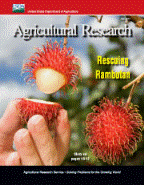United States Department of Agriculture: Agricultural Research Service, Lincoln, Nebraska

Agricultural Research Magazine
Date of this Version
4-2013
Document Type
Article
Citation
Agricultural Research April 2013
Abstract
Before a disease can be treated, it must first be identified. But that’s not always easy, especially in the case of Johne’s disease, which affects cattle, sheep, goats, deer, and other ruminants.
Johne’s disease—also known as “paratuberculosis”— is a costly, contagious disease that causes diarrhea, reduced feed intake, weight loss, and sometimes death. Annual estimated losses to cattle producers range from $40 to $227 per infected animal. For the U.S. dairy industry alone, losses exceed $220 million each year.
For years, scientists have been hampered by the fact that any antibody—a protein produced by the immune system to fight infections and foreign substances—used to detect the Johne’s disease bacterium also reacted to other environmental bacteria or maybe the pathogen responsible for bovine tuberculosis. This caused false-positive test results.
“You may think cattle are infected, based on a positive antibody test result, but they may simply have been exposed to nonpathogenic mycobacteria that’s ubiquitously present in the environment,” says microbiologist John Bannantine at the Agricultural Research Service’s National Animal Disease Center (NADC) in Ames, Iowa.
That problem, however, is now history. Bannantine and his colleagues at NADC have found an antibody that’s 100 percent specific in detecting Mycobacterium avium subspecies paratuberculosis (MAP)—the cause of Johne’s disease.
“No one else in the world has been able to find such a specific antibody that binds only to MAP strains, until now,” says Bannantine, who’s in NADC’s Infectious Bacterial Diseases Research Unit.
Included in
Agriculture Commons, Animal Sciences Commons, Food Science Commons, Plant Sciences Commons

